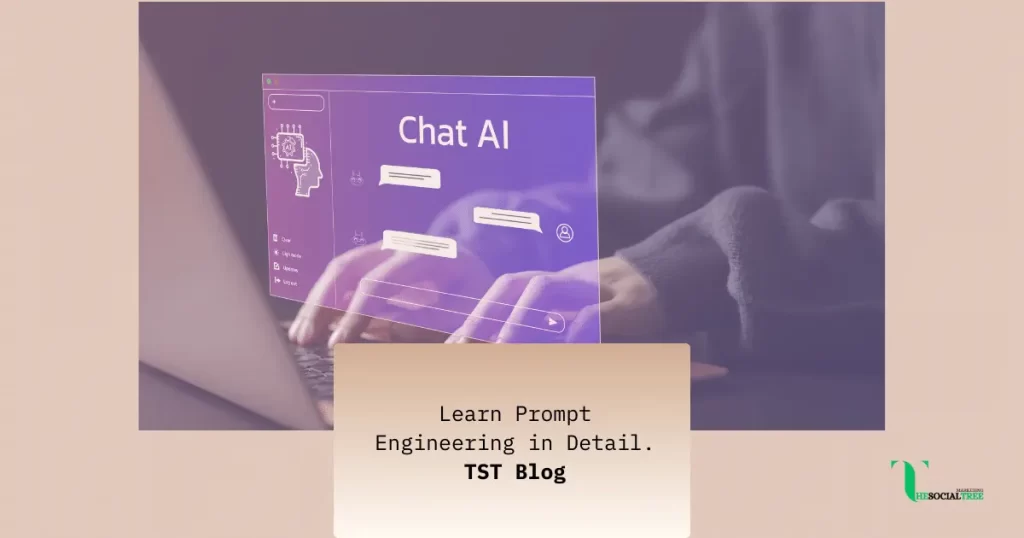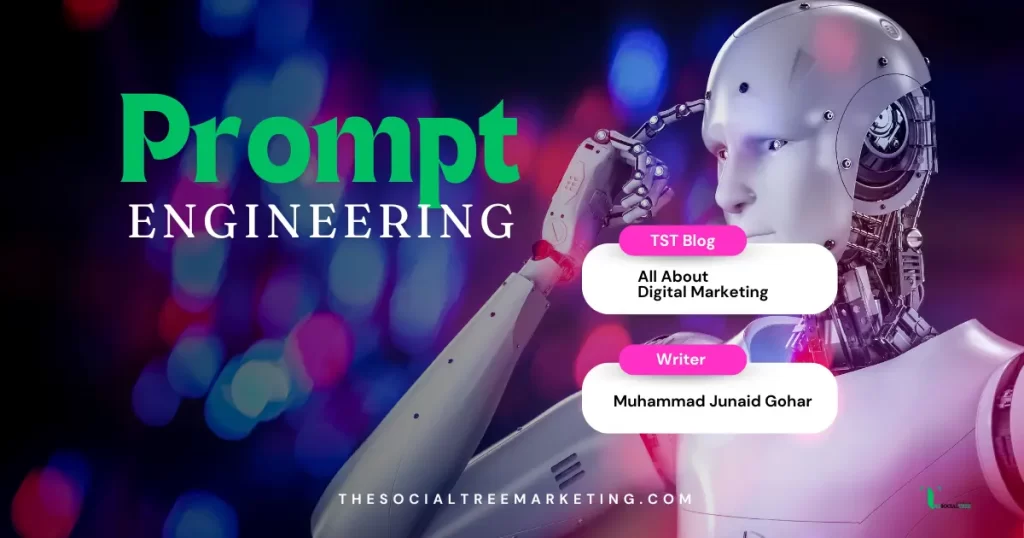Prompt engineering began with the early days of computers when programmers used machines to communicate. As artificial intelligence and natural languages developed, prompt engineering also evolved. Additionally, engineering travels over new technologies to create prompts that could serve diverse user needs and preferences. The development of prompt engineering opened the door to possibilities.
Table of Contents
ToggleWhat is Prompt Engineering?
Prompt engineering is known as the art and science of preparing exact instructions that allow users to interact with AI systems in human language. Moreover, these instructions work as input for AI systems. These prompts are also used to guide AI systems to generate accurate outputs. As Ai technology grows, there is a need arise to understand Ai tools more to get effective results.
Types of Prompt Engineering
Prompt engineering surrounds various methods tailored to many needs and preferences. Some important types are keyword-based prompts, template-based prompts, and contextual prompts. Each type is customized to suit different needs and preferences. Let’s discuss these types in detail.
1- Keyword-based prompts
A type of prompt engineering in which the user inputs particular keywords and phrases to get the desired output from AI systems is known as keyword-based engineering. Furthermore, these prompts depend on identifying predefined keywords or phrases to generate the desired outputs.
In addition, it is a common type of prompt engineering in which users simply input to the Chabot or virtual assistant to perform specific actions such as “play a song” and “set an alarm”.
Examples of Keyword-base Prompts
- “summarize main points”
- “translate English to French”
- “generate creative story”
- “write Python code”
- “explain concept simply”
- “list pros and cons”
- “provide historical context”
- “describe process step-by-step”
- “compare and contrast”
- “predict future trends”
2- Template-based prompts
In template-based engineering predefined templates or structures are used to guide interaction with AI systems. In this type of prompt engineering, users fill in particular details within these templates to build their requests.
Additionally, template-based prompt engineering gives a structured framework for communication. It also ensures clarity and consistency in interaction. Virtual assistants and Chabot use template-based prompts such as filling out a form or giving input in a structured format.
Examples of Template-base Prompts
- “Explain Remarketing in simple terms.”
- “Write a newsletter email about marketing agency.”
- “Describe the process of B2B Content Marketing step-by-step.”
- “Summarize the key points of skyscraper technique.”
- “Compare SEM and SEO in terms of [criteria].”
- “Generate a creative story about Event Marketing.”
- “List the advantages and disadvantages of PR Campaigns.”
- “Provide a historical overview of Brand Loyalty.”
- “Predict the impact of Digital Marketing on Marketing Strategies.”
3- Contextual-based Prompts
Contextual prompt engineering holds contextual information to tailor responses depending on the ongoing conversation. Moreover, contextual prompts allow AI systems to figure out and modify the context of the conversation.
In addition, contextual prompts enhance the relevance and effectiveness of outputs. These prompts examine aspects like previous instructions, user preferences, and situational context to provide more personalized experiences.
In brief, each type of prompt engineering has its strengths. All types have different abilities or applications. Developers can create numerous user-friendly AI systems that provide efficient interactions by using these types of prompt engineering.
Examples of Contextual-base Prompts
- “As a teacher, explain photosynthesis to a fifth-grade class.”
- “Given the current market trends, suggest investment strategies for 2024.”
- “In the style of a news reporter, summarize today’s top stories.”
- “From the perspective of a medical professional, describe the symptoms of flu.”
- “Considering recent advancements, explain the future of electric vehicles.”
- “As a historian, provide an analysis of the causes of World War II.”
- “In the context of a job interview, how would you describe your greatest strength?”
- “For a beginner audience, explain how to set up a personal budget.”
- “As an IT support specialist, guide a user through troubleshooting a printer issue.”
- “From the viewpoint of an environmentalist, discuss the importance of recycling.”
How prompt engineering works?

Prompt engineering starts with understanding the accurate task. Developers then design prompts using keywords or phrases that deliver the user’s purpose successfully. AI systems utilize these prompts and generate outputs based on learned patterns and data. Now, for a deeper understanding of this topic, let’s discuss working in detail
- Understand the desired task: The process starts with an intelligible understanding of what the user means to achieve. Developers search for the specific task at hand to grasp the user’s purpose. Moreover, this is a very important step for preparing prompts that guide the AI system towards the desired task.
- Designing prompts: Engineers carefully craft prompts using keywords or phrases. These prompts work as input for the AI system, directing it towards generating accurate outputs. The wording of prompts is very necessary, as it directly impacts how the AI interprets and processes user input.
- Feeding prompts into AI Models: After designing, prompts are fed into AI systems trained to figure out and respond to human language. These prompts are powered by advanced algorithms and huge datasets. AI systems analyze the prompts and generate outputs based on learned patterns and data.
- Generated outputs Based on learned patterns and data: After getting prompts, AI models grasp their learning from substantial training data to generate responses. The models recognize patterns in the prompts and draw from their knowledge to produce contextually relevant outputs.
Thus, prompt engineering allows AI systems to figure out and respond to user input efficiently with the help of this iterative process. Furthermore, it provides seamless interactions and enhances user experience.
List of 10 AI Tools
- TensorFlow
- PyTorch
- scikit-learn
- Keras
- OpenCV
- IBM Watson
- Google AI Platform
- Microsoft Azure AI
- AWS AI/ML Services
- Rasa
These tools cover a broad spectrum of AI capabilities including machine learning frameworks. Each plays a significant role in advancing AI.
Benefits of Prompt Engineering
Prompt engineering works as a stimulant for modifying how we interact with AI systems, making interaction more efficient, and personalized. Some important benefits of prompt engineering are discussed below:
1- Enhance User Experience
Prompt engineering is necessary to improve the user experience by making interactions with AI systems more instinctive and user-friendly. Precise prompts guide users through interactions efficiently. Moreover, it reduces the need for complex commands and technical knowledge as well.
2- Increased Efficiency
Well-designed prompts smooth processes, leading to enhanced efficiency in completing tasks. Prompt engineering reduces ambiguity and the likelihood of errors by providing users with clear instructions. This efficiency saves a lot of time for creators and increased productivity.
4- Personalization
Tailoring prompts to individual preferences and needs allows for personalizing interactions that strongly match users. It also enables AI systems to modify user preferences, learning from past interactions to convey more relevant responses.
5- Facilitating Innovation
Prompt engineering gives engineers the power to push the barriers of innovation across several domains. They can open up new possibilities and create innovative solutions to complex challenges by refining prompts and optimizing AI models.
Conclusion:
Prompt engineering plays an important role in forming the future of human-computer interaction. We can release the full potential of AI to improve lives, drive progress, and open up new frontiers of innovation by using the power of language.

